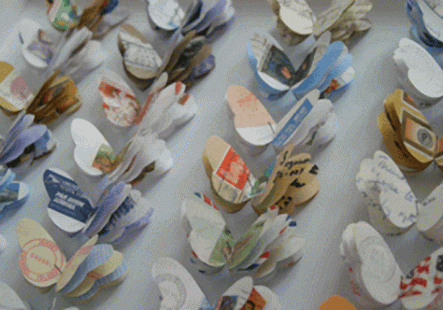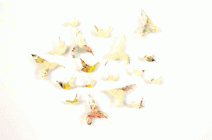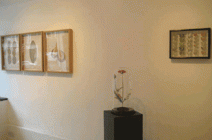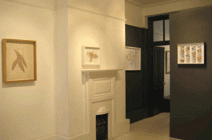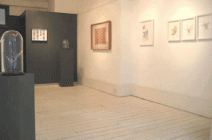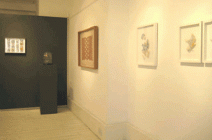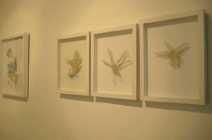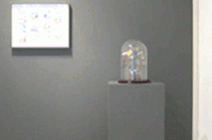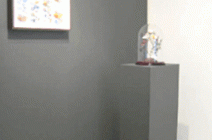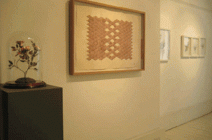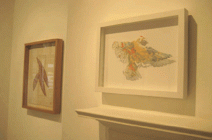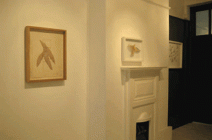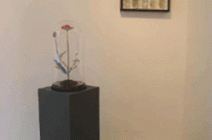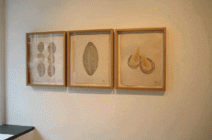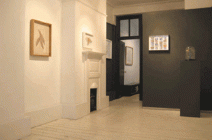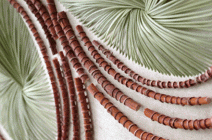The Nature of Knowledge
The Nature of Knowledge
Claire Brewster, Kazuhito Takadoi, Tracey Bush
The Nature of Knowledge presents works in which maps, letters, packaging and advertisements - stores of our cultural knowledge - find new life depicting the natural world. Material from the natural world, in turn, finds a touching poignancy when transformed into abstract forms. As we look, knowledge becomes nature, nature becomes knowledge.
In Claire Brewster's works, birds, flowers and insects are de-constructed from old maps. Having trained in Constructed Textiles at Middlesex Polytechnic, she treats old maps as fabric to create an invented flora and fauna of a place. An Arctic Jay or a Pacific Island Rose is silhouetted from masses of water and land, with lines signaling latitudes, longitudes and exact geographical locations. But origin and location does not seem to matter as her creatures appear to want to break free from the confines of the frame, to migrate to faraway lands. Intricate, detailed, delicate cut out shapes emerge resembling elaborate lace or tapestries. Thus, ideas of freedom, that anyone can travel and stay where they like, as a current political reality as well as issues of biodiversity, the migration of foreign species and the consequent damage to the environment underlie her beautiful works.
Hundreds of butterflies cut out of foreign postmarked envelopes and letters are pinned down in Tracey Bush's The Postman. For many years she has made scrapbooks; collections of ephemera that she could not throw away. These books have now emerged as Lepidoptera, butterflies and moths; ancient symbols of transformation. Each moth or butterfly is sewn together from layers of paper using a bookbinder's pamphlet stitch and then pinned out using entomological pins in Museum boxes. British Butterflies is cut from old maps and atlases. Each butterfly is an actual species and is life size. Each is made with an allusion to its name or habitat. Their poetic names are hand-written in brown ink on tiny scientific labels. Butterflies are amongst the first indicators of environmental change; these works hope to highlight their frailty and diversity, as an alternative to a collection of actual specimens.
It has been estimated that the average Western adult can recognise a thousand brand names and logos, but less than ten wild plants. In Nine wild plants, Bush draws on a culture of collecting, making three-dimensional flowers made of recycled paper picked up from London's streets and presenting them in taxidermy cases. The plants used as specimen types were also collected in the London area. Some might be considered weeds and are often overlooked. Nine wild plants combine the precision of carefully observed botanical constructions, with the overblown excesses of consumerism.
Kazuhito Takadoi works primarily with organic-based material - twigs, willow and papyrus. Having trained in Agriculture and Horticulture both in Japan and in the UK, Takadoi then studied Art and Garden Design. The weeds, grasses and materials he uses in his works are grown by him in pots in his back garden. He builds up his exquisite 3 dimensional collages on Japanese hand-made washi paper using many techniques adapted from embroidery. His minimalist yet ornate works with their beautiful oak frames relate to Japanese architecture, Ikebana and kimono fabrics. Although apparently abstract each work relates a story, a connection with nature, both in its content and material -a full moon rising, water drops, trees in a forest. The natural materials used in his art have no preservatives, chemicals nor colourants. Over a period of time there is a slow aging process and subtle colour changes as one may see in nature, his works age beautifully as they gain maturity.

